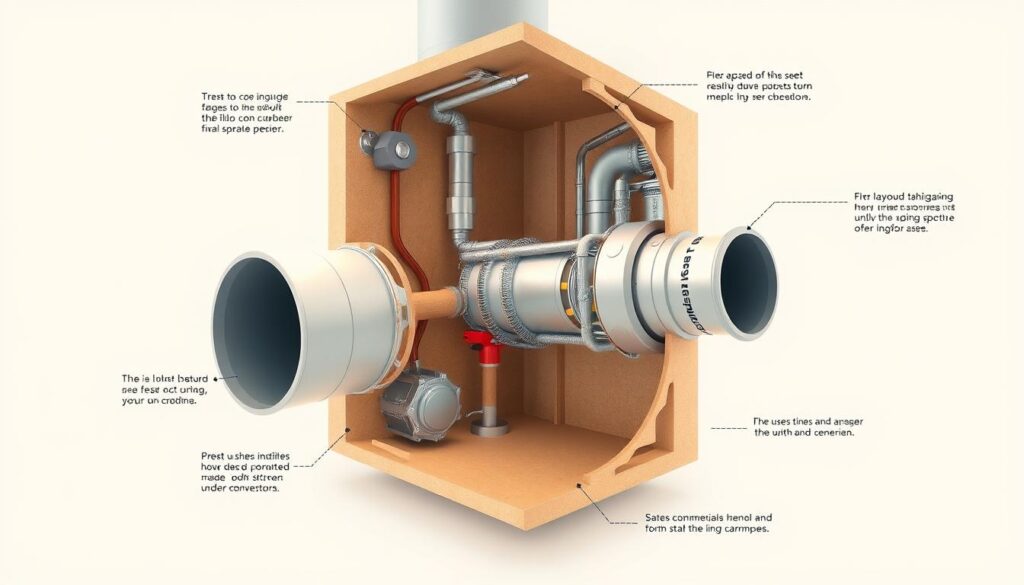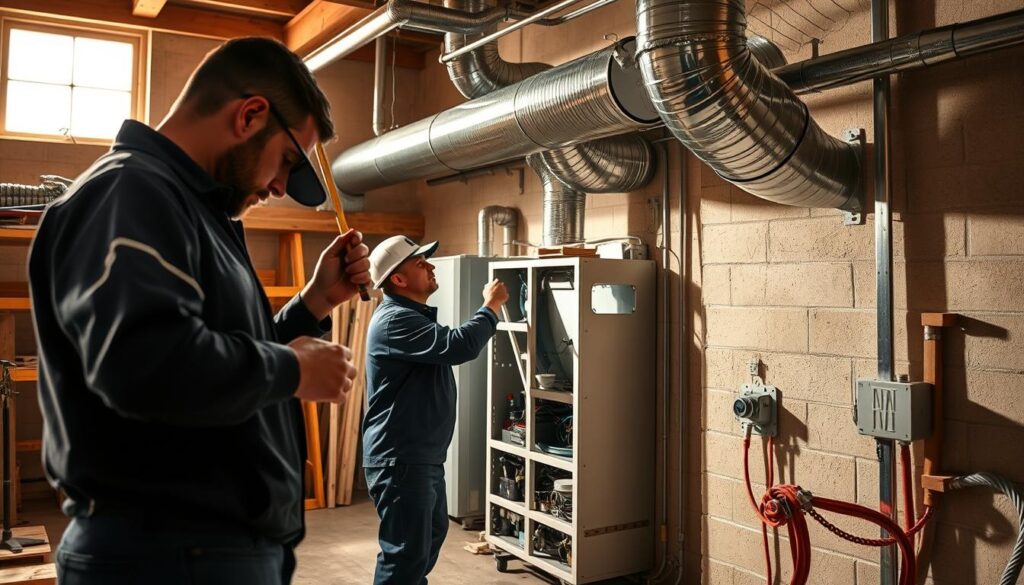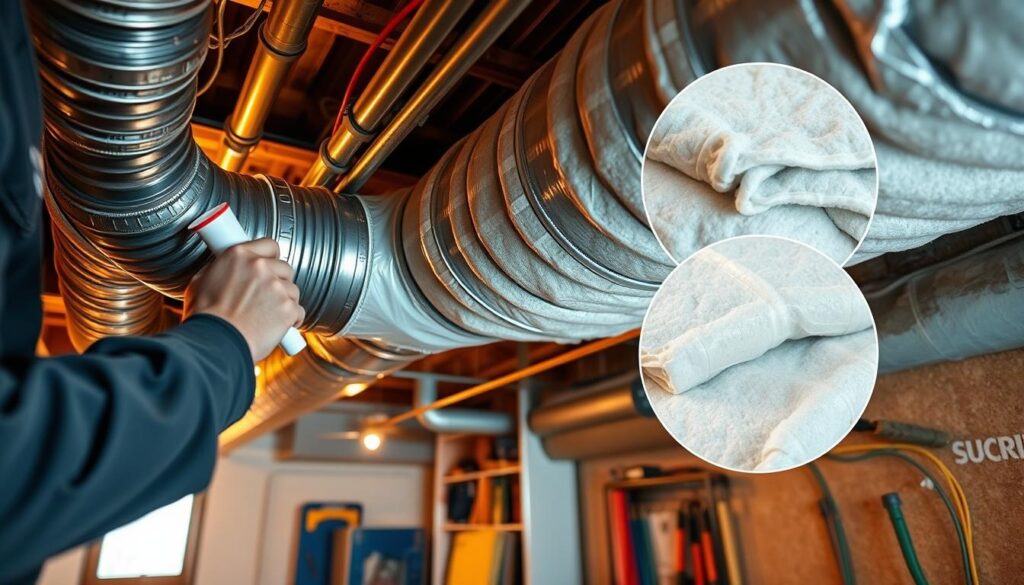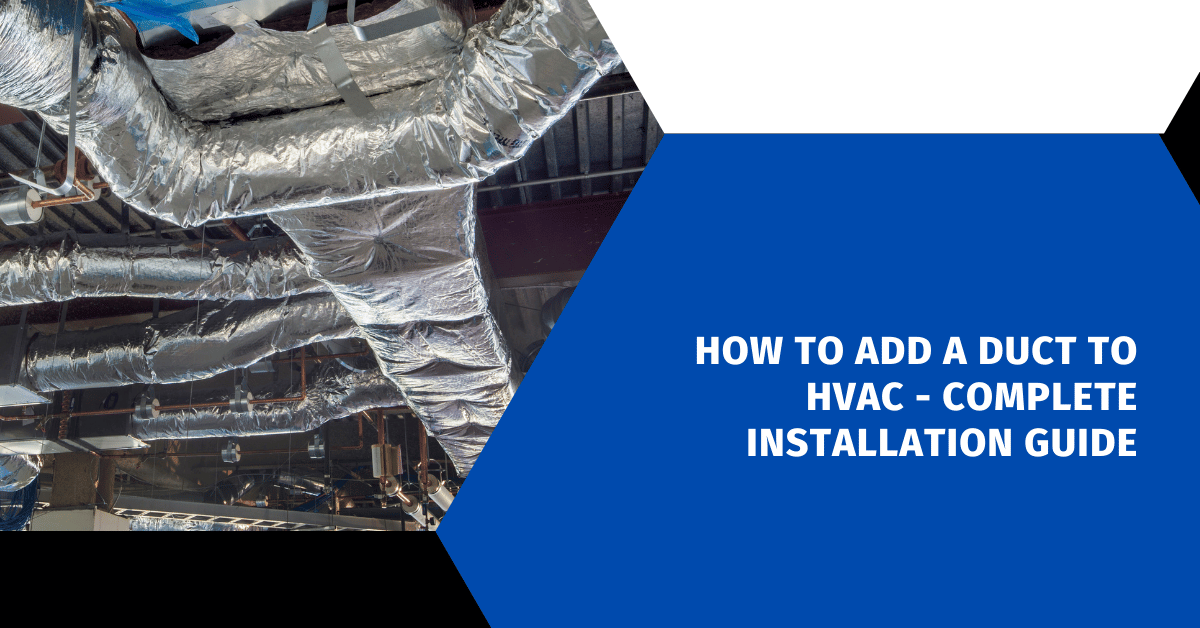Affiliate Disclosure
HVAC Guide Guys is a participant in the Amazon Services LLC Associates Program, an affiliate advertising program designed to provide a means for sites to earn advertising fees by advertising and linking to Amazon.
How to Add a Duct to HVAC? Are you tired of uneven temperatures and high energy bills? You can improve your HVAC system’s performance by adding a duct yourself. HVAC duct installation might seem tough, but you can save up to $2,500 by doing it yourself.

Learning to add a duct to HVAC is more than saving money. It’s about making your home more comfortable. This guide will show you how to do it, from the basics to a professional-quality installation.
If you love DIY projects or want to improve your heating and cooling system, this guide is for you. It will help you install ducts with confidence and skill.
Key Takeaways
- DIY duct installation can save significant money on professional services
- Proper ductwork improves home comfort and energy efficiency
- Understanding HVAC system components is crucial for successful installation
- Careful planning prevents common installation mistakes
- Precise measurements and techniques ensure optimal airflow
Table of Contents
Understanding HVAC Ductwork Basics
HVAC ductwork is like the veins of your home’s climate system. It carries air to keep your home comfy and clean. Knowing how it works helps you keep your home’s air just right.
Types of Ducts and Their Functions
Different materials make up your home’s ductwork. Each type has its own job:
- Rigid Metal Ducts: These are strong and let air flow smoothly
- Flexible Ducts: Great for tight spots because they’re light and easy to bend
- Fiberglass Lined Ducts: They help keep sound and heat out
Essential Components of HVAC Systems
Your HVAC system has important parts. Supply ducts send air to rooms, return ducts pull it back, and air handlers control temperature and air flow.
Importance of Proper Duct Installation
Getting your ductwork right is key. It affects how well your system works, how much energy it uses, and the air quality. Bad installation can cause problems and cost more money. So, it’s smart to get it done right.
Explore Our HVAC Shop
Looking for top-rated HVAC tools, parts, and accessories? Visit our shop and find the perfect solution for your needs.
Visit the ShopRequired Tools and Materials for Duct Installation
Getting ready for HVAC duct installation means picking the right tools and materials. You need the right gear to do a job well and fast.
For HVAC duct installation, you’ll need a set of precise tools. They make your work easier and more accurate:
- Measuring and Cutting Tools:
- Tape measure
- Circular saw
- Reciprocating saw
- Straight bench snips
- Right and left hand metal snips
- Fastening and Fitting Tools:
- Drill with 1/4″ hexhead driver
- Hand seamers
- Barfold tool
- Claw hammer
Choosing the right materials for your HVAC ducts is key. Look for durability and fit with your HVAC system. Common materials are:
- Galvanized steel
- Aluminum
- Flexible ductwork
- Fiberglass duct board
Safety is always first. Don’t forget to wear important protective gear:
- Work gloves
- Safety glasses
- Dust mask
- Protective footwear
Pro tip: Get specialized tools like a sheet metal hole cutter for tight spots. These tools can make your installation smoother and help you get professional results.
Explore Our HVAC Shop
Looking for top-rated HVAC tools, parts, and accessories? Visit our shop and find the perfect solution for your needs.
Visit the ShopPlanning Your HVAC Duct Layout
Creating a good HVAC duct layout is key for comfort and saving energy. The design of your ductwork affects how well your heating and cooling system works. So, planning carefully is vital for a successful installation.
Creating a smart hvac duct layout needs a lot of detail and knowing what your home needs. Experts say you should plan everything out before you start cutting ductwork.
Measuring and Mapping Duct Routes
When you’re mapping out your hvac duct layout, keep these points in mind:
- Room sizes and shapes
- What your ceiling and walls are like
- Any existing mechanical systems
- Things like plumbing and electrical systems that might get in the way
Calculating Proper Duct Sizing
Getting the right size for your hvac ducts is crucial for good system performance. Ducts that are too small or too big can cause bad airflow and higher energy bills.
| Room Size | Recommended Duct Size | Airflow Requirement |
|---|---|---|
| 100-150 sq ft | 6-inch diameter | 150-250 CFM |
| 150-250 sq ft | 8-inch diameter | 250-400 CFM |
| 250-400 sq ft | 10-inch diameter | 400-500 CFM |
Determining Register Locations
Where you place your registers is important for even heating. Consider these things:
- Keep 8″ away from walls
- Don’t block the registers with furniture
- Help air move around better
- Make sure supply and return air are balanced
Pro tip: Always check with a professional HVAC technician to make sure your duct layout and sizing are right.
How to Add a Duct to HVAC: Step-by-Step Process
Adding a duct to your HVAC system needs careful planning and precise steps. The process might seem tough, but with the right steps, you can extend your home’s ventilation.

- Measuring tape
- Utility knife
- Sheet metal cutters
- Duct tape
- Protective gloves
- Sealant
Here are the key steps for duct installation:
- Find the existing ductwork for the new connection
- Measure the duct length needed
- Use metal cutters to cut an opening in the duct
- Prepare the new duct section with the right measurements
- Secure the new duct with tight connections
Being precise is key in duct installation. Make sure all seals are tight to avoid air leaks and keep the system efficient.
| Installation Step | Key Considerations |
|---|---|
| Cutting Opening | Use clean, straight cuts for best connection |
| Duct Attachment | Secure with metal screws and duct sealant |
| Insulation | Wrap connections to prevent energy loss |
Pro tip: Always wear protective equipment and work carefully to avoid damaging existing ductwork.
Explore Our HVAC Shop
Looking for top-rated HVAC tools, parts, and accessories? Visit our shop and find the perfect solution for your needs.
Visit the ShopInstalling Supply and Return Ducts
HVAC duct installation is key for efficient air flow in your home. Knowing about supply and return ducts helps make your home more comfortable and energy-saving.
Your HVAC ductwork is crucial for indoor comfort. Supply and return ducts work together. They ensure your home stays at the right temperature.
Supply Duct Installation Techniques
When setting up supply ducts, pay attention to a few important things:
- Measure the space carefully before cutting
- Use proper sealing techniques to prevent air leaks
- Ensure smooth connections between duct sections
- Maintain consistent duct sizing for optimal airflow
Return Duct Configuration
Return ducts are just as vital in your HVAC system. They pull air from various rooms and send it back to the main unit for cooling.
- Select strategic locations for return air grilles
- Ensure adequate space around return duct openings
- Use proper sizing to prevent airflow restrictions
Connecting to Main Trunk Lines
Connecting to main trunk lines is essential for a good HVAC system. You need to make secure, well-sealed connections. This helps prevent air loss and boosts system performance.
Pro tip: Always use high-quality sealing materials and follow manufacturer guidelines during hvac duct installation.
Proper Duct Sealing and Insulation Methods

Keeping your HVAC system running well is key. This means sealing and insulating your ducts right. If they’re not, you’ll waste energy and feel less comfortable at home.
For sealing your hvac ducts, pay attention to a few important spots:
- Find and fix air leaks
- Choose the right sealing materials
- Check duct connections
- Look over all joints and connections
Pro tip: Mastic sealant is better than tape for lasting results.
When it comes to insulating your ducts, remember these points:
- Pick insulation that fits your local climate
- Focus on ducts in places like attics and crawl spaces
- Use insulation with the right R-value
- Make sure it covers everything evenly without squishing it
“Proper duct sealing can reduce your energy costs by up to 20%” – Energy Star Recommendation
Getting your HVAC system to work better is all about sealing and insulating right. By doing this, you’ll breathe cleaner air, use less energy, and make your system work better.
Explore Our HVAC Shop
Looking for top-rated HVAC tools, parts, and accessories? Visit our shop and find the perfect solution for your needs.
Visit the ShopCommon Installation Mistakes to Avoid
Even pros can make big mistakes when installing hvac ducts. Knowing these common errors can save you from expensive fixes and keep your HVAC running smoothly.
Professional hvac duct maintenance is all about avoiding common pitfalls. Let’s look at the main mistakes to steer clear of in your ductwork project.
Air Flow Restrictions
Airflow issues can make your HVAC system less efficient. Be on the lookout for these problems:
- Sharp bends in flexible ductwork
- Improperly sized ducts
- Blocked or compressed duct sections
- Excessive length in duct runs
Improper Sealing Techniques
Wrong sealing can cause big energy losses and lower system performance. Here are key sealing tips:
| Sealing Method | Effectiveness | Recommended Use |
|---|---|---|
| Metallic Tape | High | Temporary connections |
| Mastic Sealant | Very High | Permanent joints |
| Silicone Caulk | Medium | Small gaps and cracks |
Support and Mounting Errors
Right duct support is key for system longevity. Wrong mounting can lead to:
- Sagging ductwork
- Increased noise during operation
- Potential structural damage
- Reduced overall system efficiency
By tackling these common hvac duct installation issues, you can have a more reliable and efficient heating and cooling system. Paying attention to details during installation avoids future maintenance troubles.
Testing and Balancing New Ductwork
After installing new HVAC ductwork, testing and balancing are key steps. They ensure your system works at its best. Proper maintenance starts with checking airflow and making adjustments for efficient air distribution.
The balancing process includes several important steps. These steps help optimize your HVAC system’s performance:
- Measure airflow at each register using an anemometer
- Check for any air flow restrictions or uneven distribution
- Adjust dampers to fine-tune air balance
- Verify temperature consistency across different rooms
Each register should have its own damper for adjustments. These dampers help control and redirect airflow. Precision is key in maintaining a comfortable and energy-efficient home environment.
Professional HVAC technicians suggest regular system testing. Small imbalances can grow over time, reducing efficiency and increasing costs. Regular checks and adjustments can extend your HVAC system’s life and keep your home comfortable.
Tip: Always consult a professional HVAC technician if you’re unsure about performing balancing procedures yourself.
Conclusion
Adding a duct to your HVAC system can be a rewarding home improvement project. It requires careful planning and attention to detail. You’ve learned a lot about HVAC duct installation from this guide.
Your success depends on understanding the critical steps, from planning to testing. Proper installation ensures optimal airflow, energy efficiency, and comfort. Remember, DIY duct installation needs precision and technical knowledge.
Regular maintenance is key to keeping your ductwork in top shape. Schedule inspections to check for air leaks, blockages, or improper sealing. If you face complex challenges, don’t hesitate to seek help from professional HVAC technicians.
With the skills and knowledge you’ve acquired, you’re ready to tackle duct installation projects with confidence. Your dedication to understanding HVAC systems will improve your home’s comfort and save energy in the long run.

